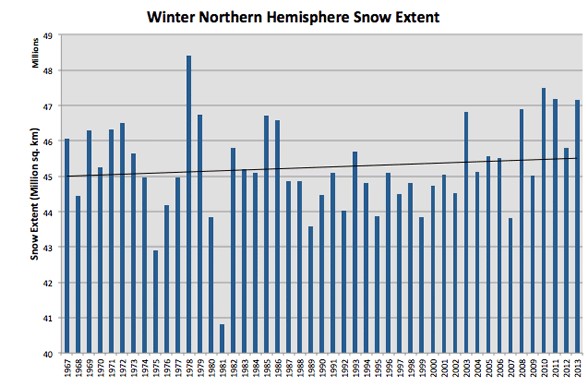Meanwhile, alarmists and climate propaganda sites such as "Skeptical Science" continue to falsely claim "record snowfall is predicted by climate models," a demonstrably false claim that is directly contradicted by this new paper and others.
Climate Dynamics October 2013
Interpreting observed northern hemisphere snow trends with large ensembles of climate simulations
L. R. Mudryk, P. J. Kushner, C. Derksen
Simulated variability and trends in Northern Hemisphere seasonal snow cover are analyzed in large ensembles of climate integrations of the National Center for Atmospheric Research’s Community Earth System Model. Two 40-member ensembles driven by historical radiative forcings are generated, one coupled to a dynamical ocean and the other driven by observed sea surface temperatures (SSTs) over the period 1981–2010. The simulations reproduce many aspects of the observed climatology and variability of snow cover extent as characterized by the NOAA snow chart climate data record. Major features of the simulated snow water equivalent (SWE) also agree with observations (GlobSnow Northern Hemisphere SWE data record), although with a lesser degree of fidelity. Ensemble spread in the climate response quantifies the impact of natural climate variability in the presence and absence of coupling to the ocean. Both coupled and uncoupled ensembles indicate an overall decrease in springtime snow cover that is consistent with observations, although springtime trends in most climate realizations are weaker than observed. In the coupled ensemble, a tendency towards excessive warming in wintertime leads to a strong wintertime snow cover loss that is not found in observations. The wintertime warming bias and snow cover reduction trends are reduced in the uncoupled ensemble with observed SSTs. Natural climate variability generates widely different regional patterns of snow trends across realizations; these patterns are related in an intuitive way to temperature, precipitation and circulation trends in individual realizations. In particular, regional snow loss over North America in individual realizations is strongly influenced by North Pacific SST trends (manifested as [natural] Pacific Decadal Oscillation variability) and by sea level pressure trends in the North Pacific/North Atlantic sectors.

No comments:
Post a Comment